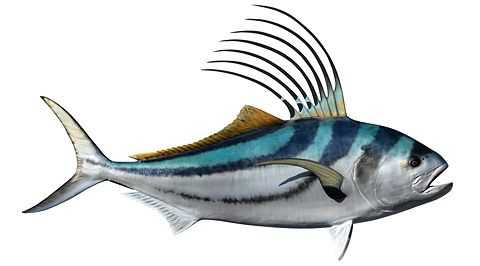Roosterfish

Species Details
Nematistius Pectoralis
Nematistiidae
Perciformes
Southern California, Pero, Panama, Costa Rica
50 - 114 lbs.
48" - 64"
What do Roosterfish eat?
Roosterfish primarily eat smaller fish species like sardines, mullet, anchovies, and invertebrates such as crabs and shrimp. They can be aggressive predators found in warm coastal waters of the Pacific Ocean.
Roosterfish (Nematistius Pectoralis) Fish Description
Roosterfish is an in-shore game fish and the only species in its family and genus. It is notable for its 'rooster comb' – and, yes, that's where it got its name. It usually has seven to eight long spines as dorsal fins usually remain at rest atop its back. But when it gets excited – and to attract its prey – it raises at an unbelievable speed. It feeds on smaller fishes such as sardines, blue runners, mullet fish, and small bonito. These make great baits to catch a Roosterfish.
It has two broad, dark diagonal stripes along the sides to the base of its tails and along their flanks. This large fish makes it great for sport fishing and looks beautiful in photos.
Anglers often just catch and release Roosterfish since it's not known for being tasty. While some anglers eat Roosterfish, some prefer not to since Its meat is tough and has a strong flavor. Catching and taking a photo with them is enough for some enthusiasts.
Interesting Fact About Roosterfish
Roosterfish's swim bladder penetrates through the large foramina and uses it to amplify the sounds in their surroundings. They are the only fish with this feature.
Size
A Roosterfish's average weight is about 110 lbs. and it can reach over 5 ft in length. Its current world record in the International Game Fish Association is 114 lbs. and 4 ft. 4 in.
Habitat and Distribution
Roosterfish are inshore fishes found in warm waters in the Eastern Pacific. They are prominent in waters around Southern California leading up to Peru. They also swim around Central America's seas, especially in Costa Rica and Panama, where they can be caught year-round.
Although they are inshore fishes and most commonly caught in the surf and waters with sandy bottoms, Roosterfish also love to swim around reefs and rocky islands. They can be seldom seen in rivers' mouths but would only come near if you use bait to lure them. However, they do not swim in brackish waters, so it would be useless to draw them there.
Fishing Techniques
The best technique to catch a Roosterfish is by trolling them slowly with live bait like blue runners, bonito, and mullet. You can also use casting lures that mimic their usual preys' patterns if live baits are unavailable.
You can also catch Roosterfish through fly fishing, although you cannot expect to get a bigger catch, especially if you cast your lines along river mouths. Roosterfish only swims through shallow water for food. Once it is full, they swim back to the deep. If you prefer this method, make you have enough bait, some minnows that you can throw on top, and crease flies.
Because of its size, you can consider Roosterfish as aggressive with incredible power, making it a bit challenging to catch one.
Roosterfish prefer long powerful runs. Just as you thought you already caught it in line, the moment it sees the boat, it will go for one last run to try to get away. Hence, you have to time your line, gather enough endurance and strength to reel it off once it catches bait.
Another tip is to gear up for it. Use a medium-heavy rod, around 13 ft. long, along with a reel outfitted with at least a 300-yard braided line. This gives you enough power on your gear alone, so you won't spend too much energy trying to fight it.







